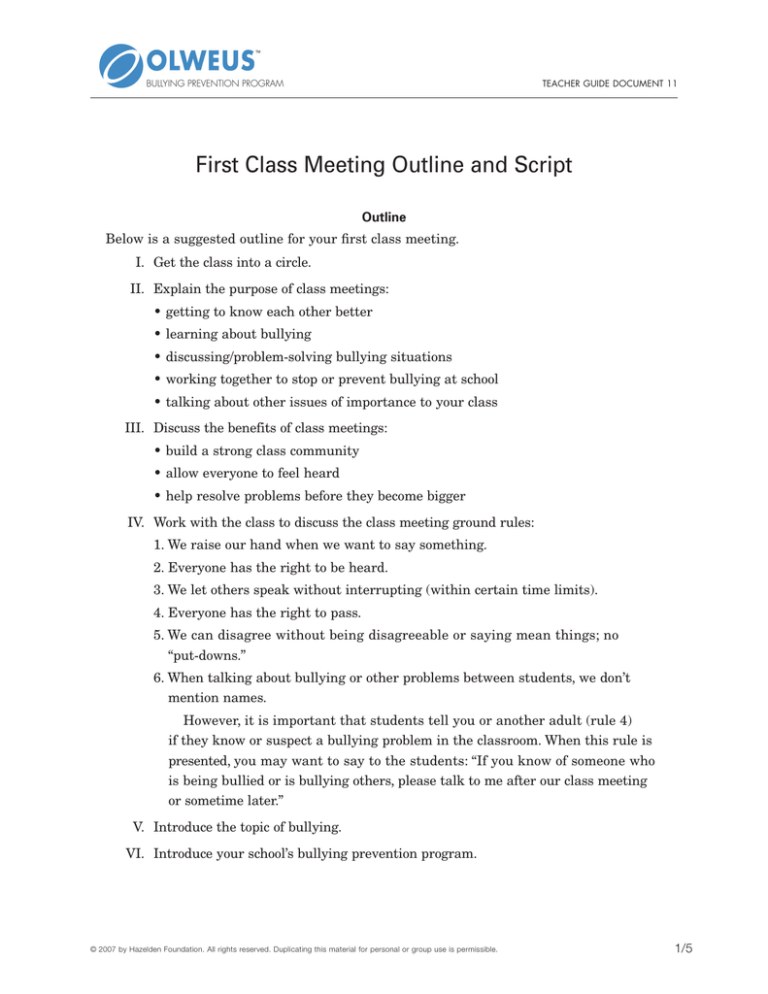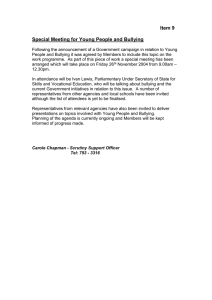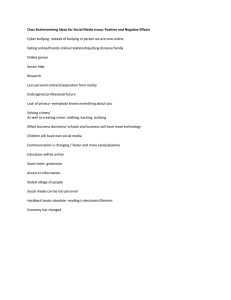
TEACHER GUIDE DOCUMENT 11
First Class Meeting Outline and Script
Outline
Below is a suggested outline for your first class meeting.
I. Get the class into a circle.
II. Explain the purpose of class meetings:
• getting to know each other better
• learning about bullying
• discussing/problem-solving bullying situations
• working together to stop or prevent bullying at school
• talking about other issues of importance to your class
III. Discuss the benefits of class meetings:
• build a strong class community
• allow everyone to feel heard
• help resolve problems before they become bigger
IV. Work with the class to discuss the class meeting ground rules:
1. We raise our hand when we want to say something.
2. Everyone has the right to be heard.
3. We let others speak without interrupting (within certain time limits).
4. Everyone has the right to pass.
5. We can disagree without being disagreeable or saying mean things; no
“put-downs.”
6. When talking about bullying or other problems between students, we don’t
mention names.
However, it is important that students tell you or another adult (rule 4)
if they know or suspect a bullying problem in the classroom. When this rule is
presented, you may want to say to the students: “If you know of someone who
is being bullied or is bullying others, please talk to me after our class meeting
or sometime later.”
V. Introduce the topic of bullying.
VI. Introduce your school’s bullying prevention program.
© 2007 by Hazelden Foundation. All rights reserved. Duplicating this material for personal or group use is permissible.
1/5
First Class Meeting Outline and Script
TEACHER GUIDE DOCUMENT 11
VII. Answer any additional questions students may have.
VIII. Let students know what they can expect at the next class meeting. Thank students
for their positive participation.
Script
Estimated time: 40 minutes
Divide this into two meetings if you are working with younger students
Following are directions and a script you may want to follow as you lead your first class
meeting. Adjust the language, as necessary, to fit the developmental levels of your students.
Suggested format:
1. Say: Today we are going to try something new. It’s called a “class meeting.”
To do this, let’s get our chairs in a circle so we can see each other. We will
move the chairs and desks back when we are done. Please be respectful
of everyone’s belongings when you do this.
2. Students should move their chairs and desks to create space for your class meeting.
3. Say: Thank you. A class meeting is different than what we normally do as
a class because we aren’t going to be focusing on a school subject. Class
meetings, which we will have once a week (or more often for younger
students), will be times when we can discuss any number of things that
are important to us.
Sometimes I will come up with a topic about something that’s going
on in our school or in the news, and sometimes you can suggest a topic.
One thing that we’ll certainly discuss is our school’s bullying prevention
program, how we are treating each other in this building, and how we
can be kinder, more respectful, and more helpful to each other.
4. Share the other purposes for class meetings as described in the class meeting
outline. Also share any other benefits of class meetings as described in the outline.
5. Say: To make sure everyone gets a chance to say his or her opinions and
feels comfortable in these class meetings, we will need a few ground rules.
What ground rules do you think are needed for everyone to feel comfortable talking?
© 2007 by Hazelden Foundation. All rights reserved. Duplicating this material for personal or group use is permissible.
2/5
First Class Meeting Outline and Script
TEACHER GUIDE DOCUMENT 11
6. Let the students come up with their own words that convey these ground rules:
a. We raise our hand when we want to say something.
b. Everyone has the right to be heard. Ask: What does that mean? How can
we make sure this happens?
c. We let others speak without interrupting (within certain time limits). Ask:
What does that mean?
d. Everyone has the right to pass. Ask: What does that mean?
e. We can disagree without being disagreeable or saying mean things; no
“put-downs.” Ask: What are some examples of put-downs?
(Remember to include the nonverbal or less obvious put-downs such as eyerolling, whispering to a neighbor, or laughing at another person’s comment.)
What are some positive ways to handle disagreements?
f. When talking about bullying or other problems between students, we don’t
mention names. Say: However, it is important to report that bullying
is happening. If you know of someone who is being bullied or is
bullying others, please talk to me after our class meeting. I will
take action to make sure the bullying stops.
7. You may add a few other ground rules that students think are important.
8. After a brief discussion, ask someone to write the agreed-upon rules on poster
board so that everyone can see them. Ask a student to be in charge of bringing out
the poster for each class meeting. There is also a poster of the ground rules on the
Teacher Guide CD-ROM (document 9) that you might want to use instead.
9. Say: Thank you. Let me explain a little more about class meetings. We are
here to get to know one another better and to work together better as a
group. We can discuss life here at school, such as the way students relate
to each other, things you are concerned about here, or improvements
you’d like to see happen. Today, I want to start talking about something
very important—bullying. What does it mean to bully someone?
10. Allow some discussion with a lot of affirmations.
11. Say: Thank you. Let me give you a definition of bullying:
A person is bullied when he or she is exposed, repeatedly and over time,
to negative actions on the part of one or more other persons, and he or
she has difficulty defending himself or herself.
© 2007 by Hazelden Foundation. All rights reserved. Duplicating this material for personal or group use is permissible.
3/5
First Class Meeting Outline and Script
TEACHER GUIDE DOCUMENT 11
Expressed in more everyday language one might say: Bullying is when
someone repeatedly and on purpose says or does mean or hurtful things
to another person who has a hard time defending himself or herself.
12. Simplify this definition if you have younger students to: Bullying is when someone says or does mean things to another person.
13. Say: Here are three more important things to know about bullying:
a. Bullying is when one student or a group of students are being mean
to another student on purpose. The students who bully continue to
act mean to the other student even though it hurts the other student’s feelings. Can you give examples of times when a student may
hurt another student on purpose?
Talk briefly about the differences between bullying, rough-and-tumble play,
and fighting. See chapter 2 of the Teacher Guide for a description of the
differences, or the chart in document 3 on the Teacher Guide CD-ROM. Tailor
the information to your students’ level.
b. In bullying there is an imbalance of power where the students who
bully use power in the wrong way—to hurt or make fun of someone.
Sometimes a bigger student is picking on a smaller student. Or, a
group of students pick on one student. There is a power imbalance,
and it is difficult for the student being bullied to make them stop.
Note: For younger students, you may need to explain what “imbalance” means.
c. Usually, bullying happens again and again. However, it is important
for you to know that if we see you bullying someone even once, you
will be asked to stop, and there will most likely be consequences.
14. Ask: What are the different ways students bully each other in this building? Remember, please don’t use names.
15. Ask students to give examples. Explain the basic types of bullying—physical or
verbal bullying or direct and indirect bullying. Explain these terms or simplify
them for younger students. Again, chapter 2 of the Teacher Guide provides background information on this.
16. Say: That’s a lot to think about. Think about whether you have ever been
bullied by someone. In what ways were you bullied? How did it make you
feel? Remember, if you’d like to discuss this in the group, please don’t
mention any names.
© 2007 by Hazelden Foundation. All rights reserved. Duplicating this material for personal or group use is permissible.
4/5
First Class Meeting Outline and Script
TEACHER GUIDE DOCUMENT 11
17. Allow for discussion with a lot of affirmations. Be sure other students don’t make
fun of people as they share.
18. Say: Bullying really hurts those who are bullied. We feel so strongly at our
school that bullying should not happen, that we have decided to start a
bullying prevention program—the Olweus Bullying Prevention Program
(or OBPP for short). Everyone in our school, staff and students alike, will
be participating in this program. We want to make sure our school is a
place where people care about each other and bullying never happens.
We will talk more about this at future class meetings.
19. Give students some examples of bullying topics you may discuss at future class
meetings (as outlined on pages 72–75 in the Teacher Guide). Let students know
that they will first learn the four anti-bullying rules, starting with rule 1, next time.
Ask students to share ideas of topics they would like to discuss. If there are no
suggestions, tell them to think about it and bring ideas to your next class meeting.
20. Also ask students if they have any questions about class meetings, your class meeting ground rules, and so on.
21. Say: Well, we just had our first class meeting. Thanks for trying it out
with me. It looks like we’ll have a lot to talk about. Think about this topic
of bullying and we can pick up our discussion again next time. Bullying
is an important topic for us, but we will also be talking about many other
topics in our class meetings throughout the school year. Again, we’ll be
meeting once each week.
22. Say: Please return the chairs and desks to their original location, and be
careful and respectful of each other in doing so.
. . .
© 2007 by Hazelden Foundation. All rights reserved. Duplicating this material for personal or group use is permissible.
5/5






